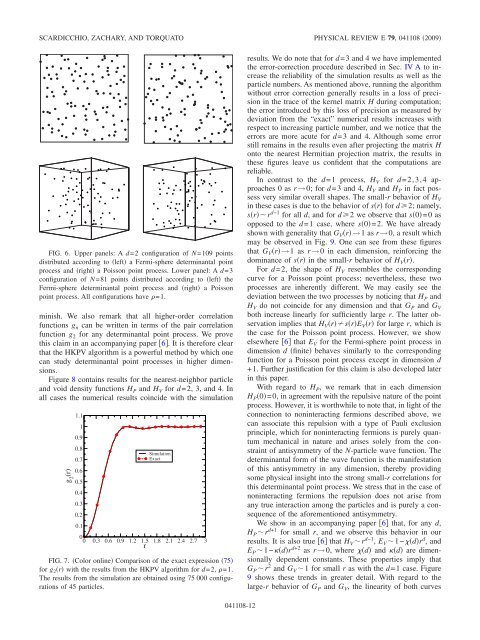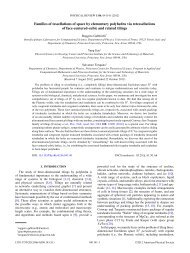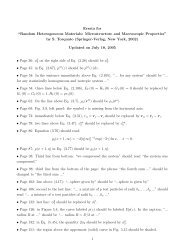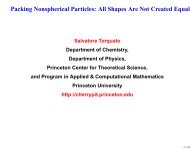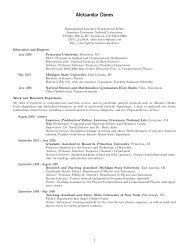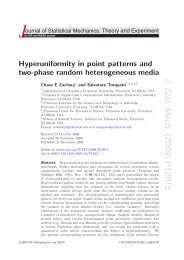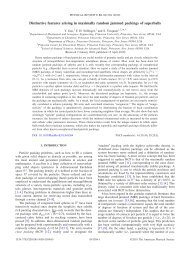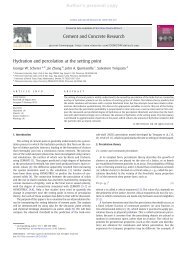Statistical properties of determinantal point processes in high ...
Statistical properties of determinantal point processes in high ...
Statistical properties of determinantal point processes in high ...
Create successful ePaper yourself
Turn your PDF publications into a flip-book with our unique Google optimized e-Paper software.
SCARDICCHIO, ZACHARY, AND TORQUATO PHYSICAL REVIEW E 79, 041108 2009<br />
FIG. 6. Upper panels: A d=2 configuration <strong>of</strong> N=109 <strong>po<strong>in</strong>t</strong>s<br />
distributed accord<strong>in</strong>g to left a Fermi-sphere <strong>determ<strong>in</strong>antal</strong> <strong>po<strong>in</strong>t</strong><br />
process and right a Poisson <strong>po<strong>in</strong>t</strong> process. Lower panel: A d=3<br />
configuration <strong>of</strong> N=81 <strong>po<strong>in</strong>t</strong>s distributed accord<strong>in</strong>g to left the<br />
Fermi-sphere <strong>determ<strong>in</strong>antal</strong> <strong>po<strong>in</strong>t</strong> process and right a Poisson<br />
<strong>po<strong>in</strong>t</strong> process. All configurations have =1.<br />
m<strong>in</strong>ish. We also remark that all <strong>high</strong>er-order correlation<br />
functions g n can be written <strong>in</strong> terms <strong>of</strong> the pair correlation<br />
function g 2 for any <strong>determ<strong>in</strong>antal</strong> <strong>po<strong>in</strong>t</strong> process. We prove<br />
this claim <strong>in</strong> an accompany<strong>in</strong>g paper 6. It is therefore clear<br />
that the HKPV algorithm is a powerful method by which one<br />
can study <strong>determ<strong>in</strong>antal</strong> <strong>po<strong>in</strong>t</strong> <strong>processes</strong> <strong>in</strong> <strong>high</strong>er dimensions.<br />
Figure 8 conta<strong>in</strong>s results for the nearest-neighbor particle<br />
and void density functions H P and H V for d=2, 3, and 4. In<br />
all cases the numerical results co<strong>in</strong>cide with the simulation<br />
g 2 (r)<br />
1.1<br />
1<br />
0.9<br />
0.8<br />
0.7<br />
0.6<br />
0.5<br />
0.4<br />
0.3<br />
0.2<br />
0.1<br />
Simulation<br />
Exact<br />
0<br />
0 0.3 0.6 0.9 1.2 1.5 1.8 2.1 2.4 2.7 3<br />
r<br />
FIG. 7. Color onl<strong>in</strong>e Comparison <strong>of</strong> the exact expression 75<br />
for g 2r with the results from the HKPV algorithm for d=2, =1.<br />
The results from the simulation are obta<strong>in</strong>ed us<strong>in</strong>g 75 000 configurations<br />
<strong>of</strong> 45 particles.<br />
041108-12<br />
results. We do note that for d=3 and 4 we have implemented<br />
the error-correction procedure described <strong>in</strong> Sec. IV A to <strong>in</strong>crease<br />
the reliability <strong>of</strong> the simulation results as well as the<br />
particle numbers. As mentioned above, runn<strong>in</strong>g the algorithm<br />
without error correction generally results <strong>in</strong> a loss <strong>of</strong> precision<br />
<strong>in</strong> the trace <strong>of</strong> the kernel matrix H dur<strong>in</strong>g computation;<br />
the error <strong>in</strong>troduced by this loss <strong>of</strong> precision as measured by<br />
deviation from the “exact” numerical results <strong>in</strong>creases with<br />
respect to <strong>in</strong>creas<strong>in</strong>g particle number, and we notice that the<br />
errors are more acute for d=3 and 4. Although some error<br />
still rema<strong>in</strong>s <strong>in</strong> the results even after project<strong>in</strong>g the matrix H<br />
onto the nearest Hermitian projection matrix, the results <strong>in</strong><br />
these figures leave us confident that the computations are<br />
reliable.<br />
In contrast to the d=1 process, H V for d=2,3,4 approaches<br />
0 as r→0; for d=3 and 4, H V and H P <strong>in</strong> fact possess<br />
very similar overall shapes. The small-r behavior <strong>of</strong> H V<br />
<strong>in</strong> these cases is due to the behavior <strong>of</strong> sr for d2; namely,<br />
srr d−1 for all d, and for d2 we observe that s0=0 as<br />
opposed to the d=1 case, where s0=2. We have already<br />
shown with generality that G Vr→1 asr→0, a result which<br />
may be observed <strong>in</strong> Fig. 9. One can see from these figures<br />
that G Vr→1 asr→0 <strong>in</strong> each dimension, re<strong>in</strong>forc<strong>in</strong>g the<br />
dom<strong>in</strong>ance <strong>of</strong> sr <strong>in</strong> the small-r behavior <strong>of</strong> H Vr.<br />
For d=2, the shape <strong>of</strong> H V resembles the correspond<strong>in</strong>g<br />
curve for a Poisson <strong>po<strong>in</strong>t</strong> process; nevertheless, these two<br />
<strong>processes</strong> are <strong>in</strong>herently different. We may easily see the<br />
deviation between the two <strong>processes</strong> by notic<strong>in</strong>g that H P and<br />
H V do not co<strong>in</strong>cide for any dimension and that G P and G V<br />
both <strong>in</strong>crease l<strong>in</strong>early for sufficiently large r. The latter observation<br />
implies that H VrsrE Vr for large r, which is<br />
the case for the Poisson <strong>po<strong>in</strong>t</strong> process. However, we show<br />
elsewhere 6 that E V for the Fermi-sphere <strong>po<strong>in</strong>t</strong> process <strong>in</strong><br />
dimension d f<strong>in</strong>ite behaves similarly to the correspond<strong>in</strong>g<br />
function for a Poisson <strong>po<strong>in</strong>t</strong> process except <strong>in</strong> dimension d<br />
+1. Further justification for this claim is also developed later<br />
<strong>in</strong> this paper.<br />
With regard to H P, we remark that <strong>in</strong> each dimension<br />
H P0=0, <strong>in</strong> agreement with the repulsive nature <strong>of</strong> the <strong>po<strong>in</strong>t</strong><br />
process. However, it is worthwhile to note that, <strong>in</strong> light <strong>of</strong> the<br />
connection to non<strong>in</strong>teract<strong>in</strong>g fermions described above, we<br />
can associate this repulsion with a type <strong>of</strong> Pauli exclusion<br />
pr<strong>in</strong>ciple, which for non<strong>in</strong>teract<strong>in</strong>g fermions is purely quantum<br />
mechanical <strong>in</strong> nature and arises solely from the constra<strong>in</strong>t<br />
<strong>of</strong> antisymmetry <strong>of</strong> the N-particle wave function. The<br />
<strong>determ<strong>in</strong>antal</strong> form <strong>of</strong> the wave function is the manifestation<br />
<strong>of</strong> this antisymmetry <strong>in</strong> any dimension, thereby provid<strong>in</strong>g<br />
some physical <strong>in</strong>sight <strong>in</strong>to the strong small-r correlations for<br />
this <strong>determ<strong>in</strong>antal</strong> <strong>po<strong>in</strong>t</strong> process. We stress that <strong>in</strong> the case <strong>of</strong><br />
non<strong>in</strong>teract<strong>in</strong>g fermions the repulsion does not arise from<br />
any true <strong>in</strong>teraction among the particles and is purely a consequence<br />
<strong>of</strong> the aforementioned antisymmetry.<br />
We show <strong>in</strong> an accompany<strong>in</strong>g paper 6 that, for any d,<br />
H Pr d+1 for small r, and we observe this behavior <strong>in</strong> our<br />
results. It is also true 6 that H Vr d−1 , E V1−dr d , and<br />
E P1−dr d+2 as r→0, where d and d are dimensionally<br />
dependent constants. These <strong>properties</strong> imply that<br />
G Pr 2 and G V1 for small r as with the d=1 case. Figure<br />
9 shows these trends <strong>in</strong> greater detail. With regard to the<br />
large-r behavior <strong>of</strong> G P and G V, the l<strong>in</strong>earity <strong>of</strong> both curves


